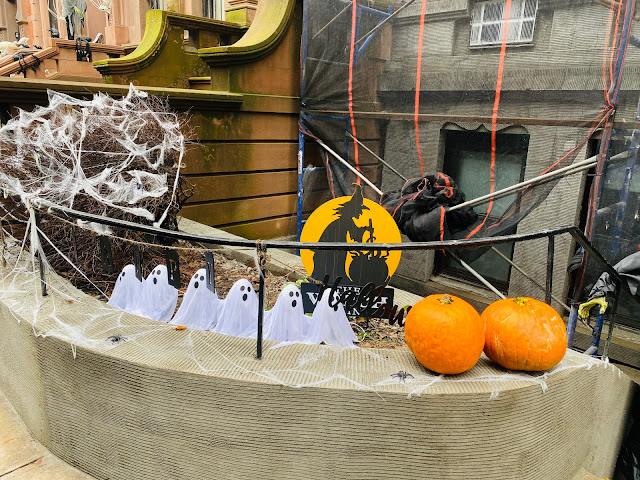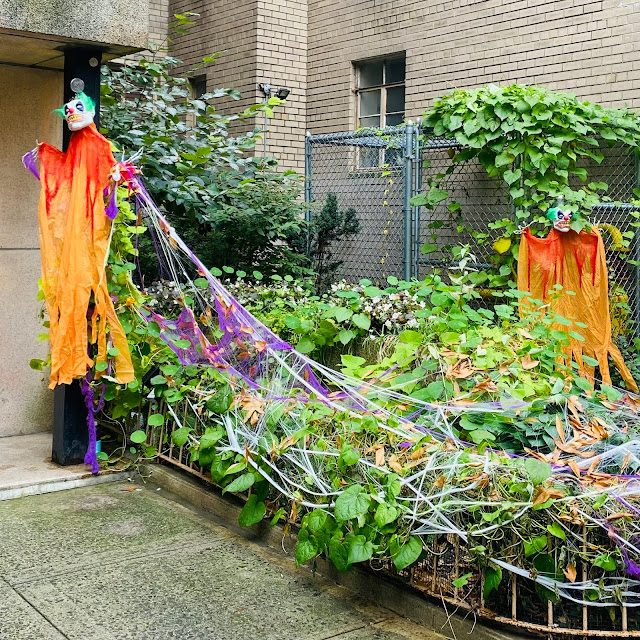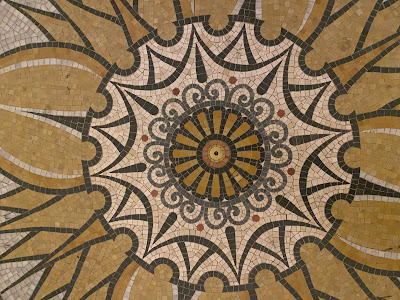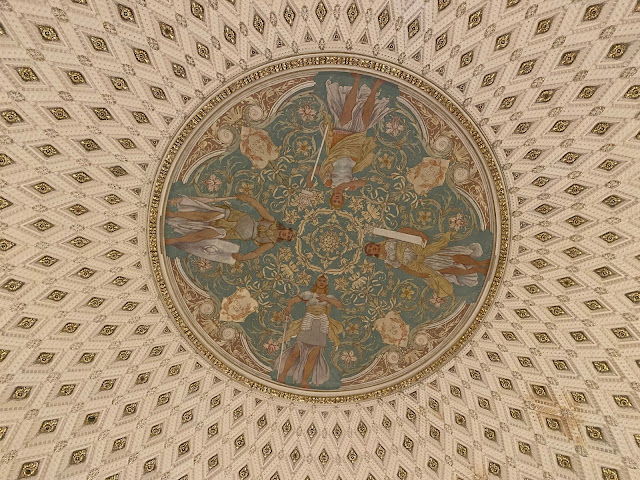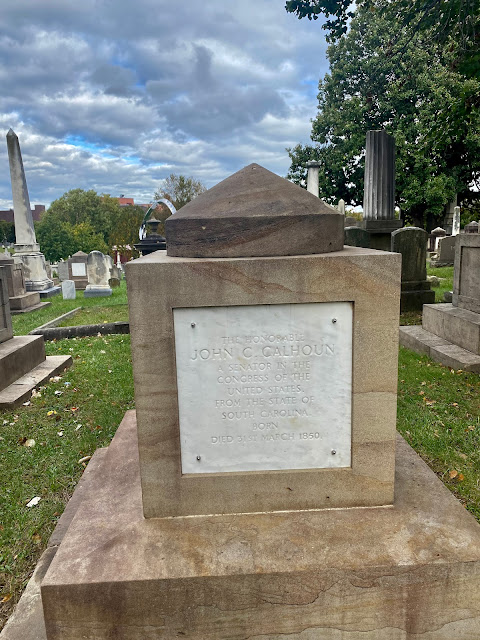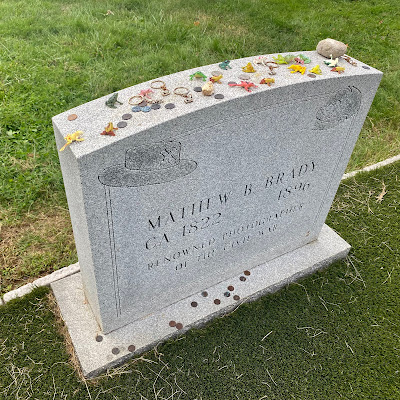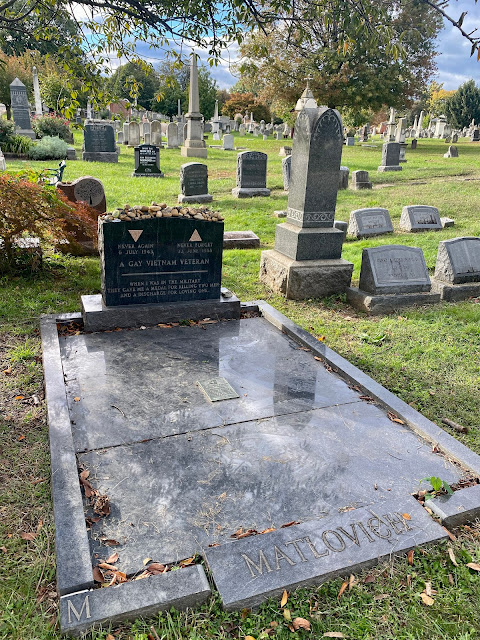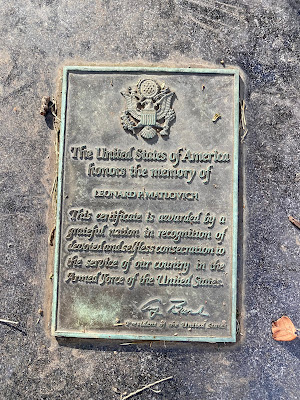Christine and I ran into her friend Wendy at the graveyard. As you do when you're in your 70s and 80s. We were in the
Congressional Cemetery where people have been laid to rest for more than two centuries in 35 acres of primo real estate.
An early 19th-century senator from Connecticut--born when that state was a British colony--was the first member of Congress to be be buried in the cemetery, which now contains the remains of 70,000 people. Many of their cenotaphs--which can mean that their actual remains are interred elsewhere--have similar shapes.
Did you know that
John C. Calhoun, the secessionist senator from South Carolina who defended slavery to his pre-Civil War death, served twice as vice-president, for both John Adams and Andrew Jackson?
Although dead members of Congress seem to have been a lot more functional--in both good ways and bad--than those still amongst us, tombstones of other folks beckoned for aesthetic, historic and personal reasons.
Functionality dictated the design of this very idiosyncratic marker.

You can't miss the very busy memorial of
Matthew Brady, the Civil War photographer, complete with Halloween skull and raven. Darkroom chemicals eventually blinded Brady; many photos attributed to him actually were taken by his staff.
It announces "The Camera Is the Eye of History."
I particularly liked this painted rock left on another tombstone.
The monument for
John Philip Sousa, who as director made the Marine Band "the President's own," includes a bench. Christine's grandson is a leatherneck currently stationed at the
Marine Barracks, within walking distance of her home on Capitol Hill.
The Congressional Cemetery is an expansion of an older Episcopal burial ground whose charter forbade the burial of "infidels" and people of color. Those oldest fogies must have spun in their graves at the inclusion of
Marion Barry, whose addiction to crack while serving three terms as mayor of the nation's capital tarnished his early and important civil rights work.
Those fogies would be even more appalled by a cemetery-published walking tour that includes an LGBT corner anchored by
Sgt. Leonard P. Matlovich, the first member of the U.S. Armed Forces to come out with an agenda while on active duty.
Said Matlovich, pithily, whose name deliberately does not appear on this tombstone: "When I was in the military, they gave me a medal for killing two men and a discharge for loving one."
Although the origins of the large marble slab around Matlovich's tombstone are unclear, I'm guessing it exists mostly to frame this belated recognization of the man's courage, a bronzed certificate presented by one of the Bush presidents, probably
George H.W., given the lack of identifying initials. The text seems both vague and inadequate for such a grandiose placement. The man deserves the
Presidential Medal for Freedom!
Matlovich, killed by AIDS at the age of 44 in 1988, rests close to
Frank Kameny, who helped him maximize the impact of his discharge from the Air Force. Kameny himself brought the first gay rights lawsuit before an American court and lost, but his persistent activism made him the grandfather of the movement.
Matlovich died in West Hollywood. Two reasons have been suggested for his decision to be buried on the right coast, one romantic and the other ironic.
Peter Doyle, another veteran (of the Confederate Army!) believed to have been the love of Walt Whitman's life, lies here too, although in an area at some remove from Matlovich.
 |
| Walt Whitman & Peter Doyle (ca 1869) |
Geography more plausibly supports the ironic explanation: Matlovich's grave is just a few plots away from that of
Clyde Tolson, J. Edgar Hoover's longtime companion.
Victor, a cemetery docent with a deaf Weimaraner, told us a great story after Christine took this photo. "Every year on his birthday, somebody climbs the fence and puts a stiletto on his tombstone." Who says cemeteries aren't fun?
Birds of a feather do flock together, even in death!


















